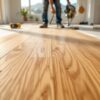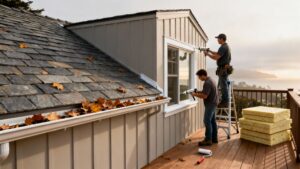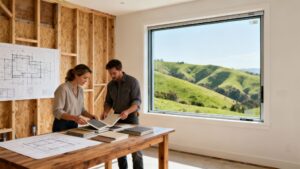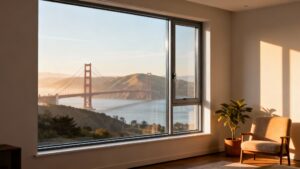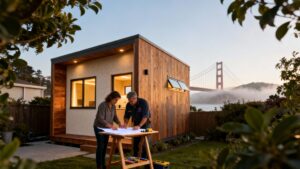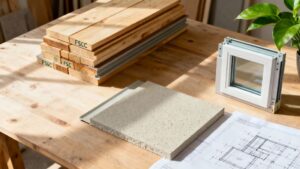When you're trying to pick the most energy-efficient window, there's a proven formula for success. Combine low U-Factor fiberglass or vinyl frames with double-pane, low-emissivity (Low-E) coated glass that's filled with argon gas.
This combination isn't just a list of features. It's a powerful thermal barrier that keeps a home comfortable and energy bills in check all year long. For the specific challenges we face in the Bay Area, this is the setup you want.
Benefits of Energy-Efficient Windows in the Bay Area
Choosing the right windows is one of the smartest investments you can make in a Bay Area property. Whether you're a builder, contractor, or homeowner, you're dealing with the region's unique microclimates. From the fog rolling into San Francisco to the sun beating down in Oakland, modern high-performance windows are your first line of defense.
This powerful insulation directly tackles rising energy costs by easing the load on heating and cooling systems. The result is a home that stays comfortable without constantly running the HVAC. When you understand how much work your windows are doing, you see their true value. For more ideas on cutting down on energy use, you can explore various HVAC energy savings strategies.

Caption: A modern home in the Bay Area featuring large, energy-efficient windows that enhance natural light and thermal performance.
Meeting California's Title 24 Building Standards
The Bay Area's commitment to sustainability isn't just a talking point—it's written into our building codes, most notably California's Title 24. This means choosing the right windows isn't just about comfort; it's about compliance. High-performance windows are essential to ensure your project meets or exceeds these mandatory energy standards.
According to the California Energy Commission, windows can be responsible for 25%–30% of a home's heating and cooling energy use. This shows just how critical a well-chosen window is for any building project in Berkeley or Oakland.
Ultimately, investing in the best windows for energy efficiency pays off in several key ways:
- Enhanced Property Value: Modern, efficient windows are a huge selling point for any home.
- Improved Occupant Comfort: No more drafty rooms or hot spots. Just consistent, pleasant indoor temperatures.
- Reduced Energy Bills: Lower heating and cooling costs deliver a tangible return on your investment, month after month.
To dive deeper into making the right choice, check out our detailed guide on selecting the best energy-efficient windows for Bay Area homes.
How to Read NFRC Labels for Bay Area Climates
When you're trying to pick the most energy-efficient windows, that little sticker from the National Fenestration Rating Council (NFRC) is your best friend. It’s the official scorecard, giving you independently verified data that cuts right through the marketing noise.
For any project in the Bay Area, knowing how to read this label is crucial for choosing a window that actually performs. For builders and homeowners in Berkeley, Oakland, and anywhere around here, two numbers matter most: the U-Factor and the Solar Heat Gain Coefficient (SHGC). Getting these right is the secret to comfort and energy savings in our unique microclimates.
Decoding U-Factor and SHGC
U-Factor is all about insulation—it measures how well a window stops heat from escaping a room. A lower U-Factor means better insulation. In the Bay Area, where we get those cool, foggy mornings and chilly nights, a low U-Factor is non-negotiable for keeping a home warm and heating bills down.
On the flip side, the Solar Heat Gain Coefficient (SHGC) tells you how much of the sun's heat a window lets in. This rating goes from 0 to 1, and a lower SHGC means less solar heat gets inside. Think about a south-facing window in sunny Oakland during the summer; a low SHGC is what keeps that room from turning into an oven and saves you a fortune on air conditioning.
Key Takeaway: For the vast majority of Bay Area homes, the sweet spot is a window with both a low U-Factor (to keep heat in) and a low SHGC (to keep unwanted solar heat out). This combo delivers the best year-round performance.
Additional Ratings to Consider
While U-Factor and SHGC are the big players for our region, a couple of other ratings on the NFRC label give you the full picture of a window's performance.
- Visible Transmittance (VT): This measures how much daylight passes through the glass. A higher VT number (from 0 to 1) means more natural light, which is great for reducing the need to flip on the lights during the day.
- Air Leakage (AL): This rating shows how much air might sneak through the window assembly. You want this number to be low—typically 0.30 or less—to minimize drafts and boost overall efficiency.
Getting a handle on air leakage is a huge part of creating a well-sealed building envelope. We cover this in more detail in our guide on weatherproofing windows and doors for Bay Area homes. By looking at all four of these NFRC ratings, you can confidently choose windows that are perfectly matched to the demands of any Bay Area climate.
Comparing Window Frame Materials for Bay Area Conditions
The frame is the backbone of any high-performance window, and here in the Bay Area, choosing the right material is a big deal. Your decision affects everything from thermal performance and durability to maintenance needs and overall style.
Let's look at how the top materials actually perform under our unique local conditions—from foggy coastal mornings to hot inland afternoons. This helps builders and architects specify the best Berkeley building materials for their projects.

Caption: This chart from Energy Star shows potential annual energy savings when upgrading from single-pane to various energy-efficient window types.
As you can see, simply upgrading from standard double-pane windows to options with advanced glazing, like triple-pane glass and Low-E coatings, can significantly increase your energy savings.
Window Frame Material Performance in the Bay Area
| Material | Thermal Performance | Durability & Maintenance | Best Suited For |
|---|---|---|---|
| Fiberglass | Excellent. Minimal expansion/contraction, ensuring tight seals and low U-Factors. | Exceptional. Resists moisture, salt, and rot. Virtually maintenance-free. | Coastal homes, high-moisture zones, and projects demanding long-term stability and efficiency. |
| Vinyl | Good. Multi-chambered frames create insulating air pockets to reduce heat transfer. | High. Requires almost no upkeep. Modern vinyl is strong and won't rot or peel. | Budget-conscious replacement projects and new construction where value is a top priority. |
| Wood | Excellent. A natural insulator that provides great thermal resistance. | High Maintenance. Requires regular sealing/painting to prevent rot in damp climates. | Historic restorations and homes where a classic, warm aesthetic is essential. |
| Aluminum | Good (Thermally Broken). The thermal break dramatically improves insulation. | High. Strong, lightweight, and weather-resistant. Doesn't rust or warp. | Modern and contemporary designs that feature large glass expanses and slim, clean lines. |
This table gives you a snapshot, but the real story is in the details of each material. Let's dig a bit deeper.
Fiberglass: The Durable Performer
When you're dealing with the Bay Area's temperature swings, you need a material that stays put. That's fiberglass. Brands like Marvin use Ultrex® pultruded fiberglass, which is incredibly stable—it barely expands or contracts. This stability is key because it prevents warping and cracking, ensuring the window's seals stay tight and effective for decades.
Thanks to its strength and resistance to moisture, saltwater, and rot, fiberglass is our top recommendation for coastal properties and homes in damp microclimates. It delivers superior insulation, helping you hit a very low U-Factor for maximum energy efficiency.
Vinyl: The Cost-Effective Solution
Modern vinyl windows hit that sweet spot between energy efficiency and value, which is why they're so popular. High-quality vinyl frames have a multi-chambered construction inside, creating insulating air pockets that do a great job of reducing heat transfer.
It’s a design that helps keep homes comfortable without a huge upfront investment. It’s an excellent go-to for replacement projects and new builds where performance and budget are equally important. You can explore a complete overview of material options in our guide on choosing energy-efficient windows.
Wood: The Timeless Classic
For certain architectural styles, especially in historic San Francisco or Berkeley homes, nothing beats the classic, warm look of wood. Wood is a fantastic natural insulator, so it offers excellent thermal performance right out of the gate.
But its biggest challenge in the Bay Area is its vulnerability to moisture. In our damp or foggy areas, wood windows demand diligent maintenance. That means regular painting or staining to prevent rot, swelling, and warping. A great compromise is a wood-clad window, which gives you a durable aluminum or fiberglass exterior with that beautiful wood interior.
Aluminum: The Modern Choice
Aluminum frames are all about strength, slim profiles, and a clean, modern look. They're perfect for contemporary designs calling for huge expanses of glass. However, standard aluminum is a poor insulator because it conducts heat so easily.
Thermally broken aluminum frames completely change the game. By inserting a non-conductive material to separate the interior and exterior frame, this "thermal break" stops heat transfer in its tracks. It dramatically improves the window's U-Factor, making aluminum a fantastic and viable option for energy-conscious projects.
Selecting the Right Glass and Glazing Technology
While a high-quality frame provides the foundation for any good window, it's the glass—what we call glazing—that does most of the heavy lifting for energy efficiency. Today's options are sophisticated systems that can dramatically change a home's comfort and utility bills.
Understanding these choices is absolutely critical for specifying the right Bay Area windows and doors. Before diving in, it helps to have a baseline understanding of the different glass types available.
Caption: A diagram showing how Low-E coatings on double-pane windows reflect heat in summer and retain it in winter.
The Power of Multiple Panes and Gas Fills
Single-pane windows are one of the biggest culprits of energy loss in a home. The solution? Add a second or even a third pane of glass to create a highly effective insulating layer. This is the simple but powerful principle behind double- and triple-pane windows.
The space between the panes is filled with a dense, non-toxic gas—most often Argon. Because Argon is much denser than air, it dramatically slows down heat transfer through the window. This is a key factor in improving its U-Factor.
Understanding Low-E Coatings
If there's one true game-changer in modern glazing, it's the Low-E (low-emissivity) coating. This is an incredibly thin, transparent layer of metallic oxide applied right onto the glass surface. Its job is simple but remarkably effective: it reflects heat.
How Low-E Works: In the winter, it reflects furnace heat back into the room, keeping the space warm and cozy. Come summer, it does the opposite, reflecting the sun's intense infrared heat away from the window to keep the home cool.
This technology is essential for managing comfort and energy bills, especially with the Bay Area's diverse microclimates.
Customizing Glazing for Bay Area Homes
Not all Low-E coatings are created equal. The right choice comes down to the window's orientation and the specific climate challenges of that exact spot. This allows you to optimize performance for each side of a house.
Let's look at a couple of real-world scenarios:
-
A South-Facing Wall in Oakland: This side of a house gets baked by the sun all day. You’d want a Low-E coating with a low SHGC to block that intense solar heat gain and slash the need for air conditioning.
-
A North-Facing Window in Berkeley: This side gets very little direct sun. Here, a Low-E coating with a higher SHGC is actually the smarter play. It allows some desirable passive solar heat in to help warm the home during cooler months, all while still providing top-notch insulation.
By strategically choosing the right glazing package for each window, you can deliver a truly customized solution that squeezes every bit of energy efficiency out of the home.
Window Solutions for Common Bay Area Projects
Knowing the technical details is one thing, but applying that knowledge to a real-world project is where it matters most. The best window choice always comes down to the project's unique goals, its location, and the architectural style. Let's walk through how to select the right windows for three common scenarios we see all the time here in the Bay Area.
Each project presents a different set of challenges, whether it's preserving historical character, maximizing a million-dollar view, or keeping commercial operating costs in check. The real art is balancing these priorities without compromising on top-tier energy performance.
Historic Victorian Renovation in San Francisco
When you're working on a historic Victorian in San Francisco, preserving its architectural soul is job number one. But those original single-pane windows are a huge source of energy loss and do next to nothing for sound insulation.
- The Challenge: Boost thermal performance and comfort without wrecking the building's classic aesthetic.
- The Solution: Wood or wood-clad windows are the best choice. A wood-clad window gives you a tough aluminum or fiberglass exterior and a traditional wood interior, striking the perfect balance between historical accuracy and modern performance.
- Glazing: Double-pane glass with a Low-E coating is a must-have to shut down drafts from the city's infamous fog and slash heating costs. Upgrading to laminated glass is also a smart move to cut down on street noise.
New Commercial Build in Oakland
For a new commercial building in Oakland, the conversation shifts entirely. Now, the focus is on long-term durability, security, and reining in operational costs like heating and cooling. The windows have to be tough, efficient, and low-maintenance.
- The Challenge: Balance the upfront investment with long-term energy savings and durability.
- The Solution: Thermally broken aluminum frames are an excellent choice. They deliver the strength and slim, modern sightlines needed for large commercial openings while stopping the heat transfer that plagues standard aluminum.
- Glazing: A low SHGC is non-negotiable. It's your best defense against the intense summer sun, reducing the load on the building's AC system—a huge factor in controlling utility bills.
Custom Home in the Berkeley Hills
A custom home up in the Berkeley Hills is almost guaranteed to have expansive glass to capture those incredible Bay views. The design puzzle is how to frame those views without creating a greenhouse that's uncomfortable and a fortune to cool.
- The Challenge: Balance massive glass expanses with the need to manage solar heat gain, especially on the south- and west-facing sides of the house.
- The Solution: High-performance fiberglass windows are a top contender. Their incredible strength can support huge window sizes with slim frames, which maximizes the view, and their stability ensures tight seals and fantastic energy efficiency.
- Glazing: This is where a tailored strategy pays off. Use a Low-E coating with a very low SHGC on windows getting blasted by direct sun. On the shaded, north-facing windows, you can use a coating with a slightly higher SHGC to allow for some passive solar warming in the winter.
Of course, understanding the initial investment is a key piece of the puzzle for any project. To help you plan, we've broken down what you can expect in our guide to the cost of energy-efficient windows.
Partner with Window Experts at Our Berkeley Lumberyard
Choosing the right windows for energy efficiency is a huge decision. It's a careful balancing act between performance, budget, and the architectural look you're going for. Getting bogged down in NFRC ratings, frame materials, and glazing options is easy, especially with the Bay Area's unique climate and codes.
Caption: The Truitt & White window and door showroom in Berkeley, where builders and homeowners can see high-performance products firsthand.
This is where having a trusted local partner really pays off. At Truitt & White, a trusted lumberyard near Oakland, our specialists have been helping builders, architects, and homeowners in Berkeley and across the region make confident choices for decades. We offer personalized consultations to make sure your project not only meets California's strict building codes but also nails your performance goals.
Stop by our Berkeley window and door showroom to see high-performance products from top-tier brands like Marvin and Andersen. Our knowledgeable team is ready to help you find the perfect solution for your build.
When you work with our experts, you’re not just buying a product; you're gaining a partner who is genuinely dedicated to your project's success. Let us help you select windows that will deliver lasting comfort, lower energy bills, and provide exceptional long-term value.
Frequently Asked Questions About Energy-Efficient Windows
Here are quick answers to common questions we get from builders, contractors, and homeowners trying to pick the right windows for a Bay Area project.
What are the most important NFRC ratings for a Bay Area home?
For almost any project in the Bay Area, you should focus on a low U-Factor and a low Solar Heat Gain Coefficient (SHGC). A low U-Factor provides the insulation needed for our cool mornings, while a low SHGC is crucial for blocking unwanted heat gain when the sun is out.
Are triple-pane windows necessary in a mild climate like Berkeley?
For most local homes, high-quality double-pane windows with a good Low-E coating strike the perfect balance between performance and cost. However, we sometimes recommend triple-pane windows for homes on busy streets to reduce noise or for properties in colder microclimates that need extra insulation.
How do energy-efficient windows help meet California Title 24 requirements?
California's Title 24 energy code sets strict performance standards for windows. Choosing products with low U-Factor and SHGC values isn't just a good idea, it's essential for passing inspection. High-performance windows make the building far more comfortable and sustainable in the long run.
What window frame material lasts the longest in coastal areas?
For coastal spots around the Bay, fiberglass is one of the best choices for durability. Fiberglass frames won't swell, rot, or warp from constant exposure to moisture and salt in the air. This gives them a much longer lifespan with less maintenance compared to other materials.
Can I improve efficiency without a full window replacement?
Yes, if your window frames are still in good shape, you don't always need to tear everything out. A sash replacement or a retrofit can give you a major boost in energy efficiency for a much lower upfront investment. The best way to know for sure is to have an expert take a look.
Ready to find the perfect energy-efficient windows for your next project? The team at Truitt & White is here to help you navigate your options with expert advice and premium products. Visit our Berkeley showroom or connect with us online to get started today.



